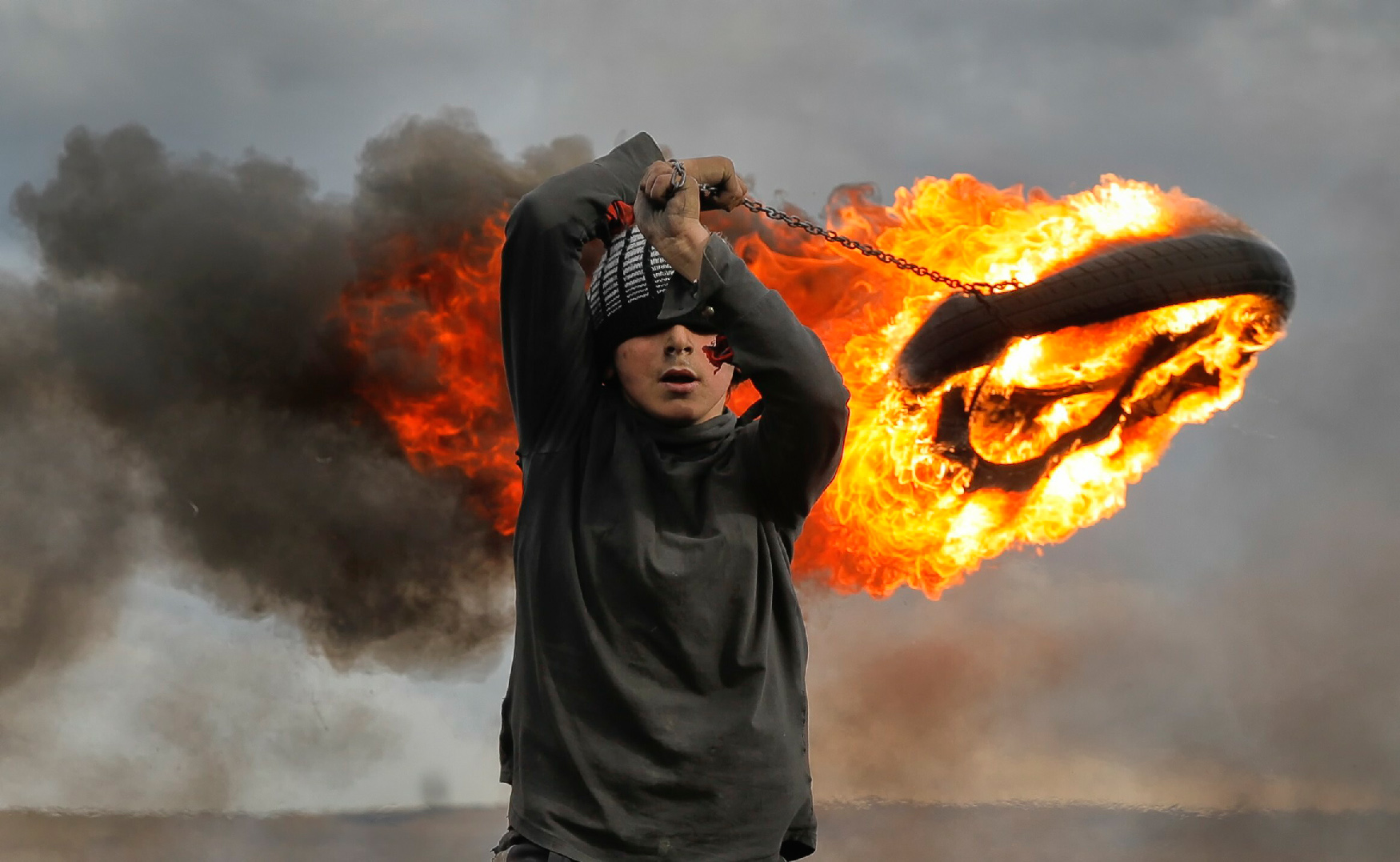Global effort to get kids out of orphanages gains momentum

Soft toys on the beds and posters on the walls. No more than three children to a room. One of the girls living in the four-bedroom house gushes about getting makeup for her birthday.
In this group home on a leafy street in Bucharest, Romania’s orphanage nightmares seem far away.
The horror stories emerged quickly after the 1989 toppling of Communist dictator Nicolae Ceausescu: shocking accounts of thousands of children beaten, starved and humiliated in overcrowded, underfunded state-run orphanages.
Sara, a child living at the Robin Hood orphanage, tries a ballet move while posing for a photo with other children in a corridor with painted windows, in Bucharest, Romania, on Friday, Nov. 3, 2017. (AP Photo/Vadim Ghirda)
Flash forward to today. The number of children in Romania’s orphanages has plummeted from more than 100,000 to about 7,000, with a goal of closing all the old-style facilities by 2023. Legions of children have been reunited with their families, placed in foster homes or relocated to cheerful family-style houses run by well-trained staff like the one in Bucharest’s 6th District.
Across the globe, intensive efforts are underway to get children out of orphanages. Bulgaria and the former Soviet republics of Georgia and Moldova have made strides. China says it’s now able to provide care for three-quarters of its orphans and abandoned children via foster homes or adoption. Rwanda is set to soon become the first African country to eliminate orphanages.
It’s a goal that remains elusive in many other countries — in India, where privately run, poorly regulated orphanages abound, and in Nepal and Haiti, where unscrupulous orphanage operators sometimes pay parents to relinquish their children and then profit from donations from sympathetic foreigners.
A boy stands next to a teddy bear missing its eyes at a foster home in Bucharest, Romania, on Wednesday, Nov. 1, 2017. (AP Photo/Vadim Ghirda)
But aid groups working to phase out orphanages believe momentum is on their side.
“We are almost at the brink of achieving a global movement — putting orphanages back into history books,” said Dr. Delia Pop, the Romanian director of global advocacy with Britain-based Hope and Homes for Children, which has worked to dismantle orphanages in 30 countries.
There’s no precise global tally of children living in orphanages. UNICEF’s latest estimate is 2.7 million, but the agency says many countries don’t accurately count children in privately run orphanages.
Sara, a child living at the Robin Hood orphanage, tries a ballet move while posing on a corridor with painted windows, in Bucharest, Romania, on Friday, Nov. 3, 2017. (AP Photo/Vadim Ghirda)
Whatever the type of facility, 80 to 90 percent of the children in them have at least one living parent, according to UNICEF.
“Most often it’s poverty driving these families apart,” said Shannon Senefeld of Catholic Relief Services. “Parents believe ... their child will be given a better way of life if they live in an orphanage.”
Yet research suggests orphanage life often harms a child in lasting ways. Even well-run institutions generally lack the affectionate care that maximizes a child’s potential, while many expose children to abuse and exploitation.
Some notable examples of orphanage reform:
A boy living in a family-style home for abandoned children poses for a photo covering his face with a clown doll in Bucharest, Romania, on Wednesday, Nov. 1, 2017. (AP Photo/Vadim Ghirda)
___
EASTERN EUROPE
Once the region with the highest rate of placing children in orphanages, Eastern Europe is now the epicenter of the movement to empty them.
In Moldova, Europe’s poorest country, the orphanage population has dropped from 11,000 to 2,000 since 2011. A similar effort in Georgia has reduced the number of state-run orphanages from 50 to two, now accommodating about 75 children rather than 5,000 in 2005, UNICEF says.
Bulgaria has won praise for focusing its reforms on children with disabilities, finding family-style care for all who had been in state institutions. Overall, the population of Bulgaria’s state-run orphanages has dropped from about 7,500 in 2010 to less than 1,200 today.
Elena, a girl living in a family style home with 10 other youths, poses for a photo in front of a painting of one of her teachers, in Bucharest, Romania, Wednesday, Nov. 1, 2017. (AP Photo/Vadim Ghirda)
In sheer numbers, Romania is the region’s paramount success story — especially in light of the Ceausescu era abuses. Agencies like Hope and Homes for Children have helped place children with foster families or in smaller homes where they can enjoy outings, birthday celebrations and a normal education.
Stefan Darabus, Hope and Homes’ regional director, says Romania’s next big challenge is to keep vulnerable families together, which benefits the children and costs the state far less than an orphanage placement.
___
ASIA
In China, orphanages mostly house children abandoned by their families because of serious medical issues.
Families faced with high medical costs — as well as rules that long restricted couples to one, and now two, children — sometimes feel they have no choice but to abandon such children, particularly if they live in poor rural areas.
A child reaches towards a minder at a foster home of the New Hope Foundation, a charity that provides care and medical treatment for babies with deformities that can be corrected with surgery, on the outskirts of Beijing, China, on Wednesday, Oct. 11, 2017. (AP Photo/Ng Han Guan)
Following reports of babies left in fields, garbage dumps and even flushed down toilets, China experimented in 2011 with opening “baby hatches” attached to orphanages to provide desperate parents a safe place to leave children they couldn’t care for. But many programs have since been suspended after being inundated with hundreds of children.
Orphanage conditions have improved over the past decade but funding is a challenge because most children require specialized medical treatment.
China is now promoting the care of such children in family settings. By late last year, there were 460,000 orphans and abandoned children in China — about 373,000 cared for through foster care or adoption, and 88,000 in orphanages, according to official statistics.
A minder lifts a child with cleft lip from a scale at a foster home of the New Hope Foundation on the outskirts of Beijing, China, on Wednesday, Oct. 11, 2017. (AP Photo/Ng Han Guan)
___
AFRICA
In Africa, where child-welfare services are sparse and millions of children live in poverty, Rwanda’s ambition to eliminate orphanages stands out.
The National Commission for Children says 3,323 children were in orphanages when the program began in 2012, and all but about 235 have been reunited with relatives or placed with adoptive or foster families.
Children rest and play at a foster home of the New Hope Foundation on the outskirts of Beijing, China, on Wednesday, Oct. 11, 2017. (AP Photo/Ng Han Guan)
The government has deployed social workers to help smooth children’s transition to post-orphanage life, but some say the program has been too drastic. They cite cases where families can’t properly feed the children returned to them, and youths leaving the orphanages end up living on the street.
UNICEF’s Greenberg applauds Rwanda’s efforts to close orphanages even while acknowledging the challenges.
“Any delay in closing these institutions is fundamentally a violation of children’s rights,” he said. “I visited a number of the orphanages. They were hell on earth, and no child should experience them.”
Children attend classes at a foster home of the New Hope Foundation on the outskirts of Beijing, China on Wednesday, Oct. 11, 2017. (AP Photo/Ng Han Guan)
A child plays with a balloon at a foster home of the New Hope Foundation on the outskirts of Beijing, China, on Wednesday, Oct. 11, 2017. (AP Photo/Ng Han Guan)
From left, tutor Vika, 11-year-old pupil, Anton, and 9-year-old Arkhip work in a room at the St. Sophia orphanage in Moscow, Russia, on Tuesday, Sept. 12, 2017. (AP Photo/Ivan Sekretarev)
Tutor Valeria and 11-year-old pupil Feruza cross through a chapel at the St. Sophia orphanage in Moscow, Russia, on Tuesday, Sept. 12, 2017. (AP Photo/Ivan Sekretarev)
Volunteer Valentina and former 11-year-old pupil Gleb walk home after visiting the St. Sophia orphanage in Moscow, Russia, on Tuesday, Sept. 12, 2017. (AP Photo/Ivan Sekretarev)
Volunteer Yelizaveta, left, looks at 4-year-old pupil, Syoma, at the St. Sophia orphanage in Moscow, Russia, on Tuesday, Sept. 12, 2017. (AP Photo/Ivan Sekretarev)
Volunteer Yelizaveta and 6-year-old former pupil, Kostya, arrive to the St. Sophia's orphanage in Moscow, Russia, on Tuesday, Sept. 12, 2017. (AP Photo/Ivan Sekretarev)
Text from the AP news story, Global effort to get kids out of orphanages gains momentum, by Alison Mutler, Gillian Wong and David Crary.
Wong reported from Beijing and Crary from New York.
Photos by Ng Han Guan, Ivan Sekretarev and Vadim Ghirda





